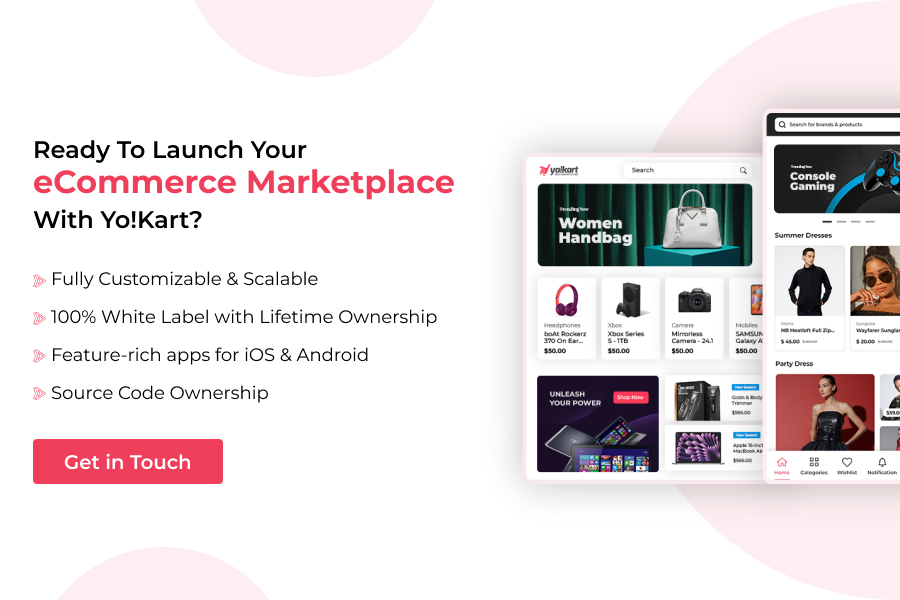How is Mobile Commerce Gaining Popularity? Enhancing Customer Experience and Convenience
Published On 09 July, 2025
Why does my eCommerce business need a mobile-focused approach?
An enhanced online shopping experience means convenience and accessibility. Mobile devices are the best tools for customers to explore products, compare prices and place orders. They can even check reviews, ratings, track orders, receive notifications and much more.
However, before we dive into the blog to explore why a mobile-friendly approach is paramount, how mobile commerce is gaining popularity, enhancing customer experience, and offering convenience while shopping online, let’s take a look at some mobile commerce statistics.
According to SellerCommerce:
- Mobile commerce sales are expected to surpass $4 trillion in 2025.
- Approximately 59% of total retail e-commerce sales originate from mobile commerce.
- 1.65 billion people shop using mobile devices globally.
- 76% of adults in the United States make online purchases using smartphones.
- 60% of internet traffic today comes from mobile devices.
Optimizing eCommerce platforms for mobile devices is a necessity rather than just an option. Businesses that are looking to establish their footprint in the eCommerce landscape must have a mobile-friendly eCommerce platform so that mobile users can interact and make purchases effortlessly.
To explore why the eCommerce industry is focusing on mobile-friendly strategies, let’s understand the role of mobile commerce in online shopping and eCommerce growth through this informative blog.
Table of Contents
- What is Mobile Commerce (mCommerce/m-Commerce)?
- Key Factors Fueling the Growth of Mobile Commerce
- Mobile Commerce Trends to Watch Out for in 2025-2026
- What are the Advantages of Building a Platform Supporting Mobile Commerce?
- Top 10 eCommerce Apps Reshaping the Future of Mobile Commerce
- Why Mobile Commerce is Crucial for Startups and New Marketplaces?
- What to Look for to Build a Mobile-Ready Marketplace Platform?
- How Can Yo!Kart Help in Building a Mobile-Friendly Online Marketplace?
- Final Thought
- FAQs
What is Mobile Commerce (mCommerce/m-Commerce)?
Mobile commerce is the process of enabling online shopping options for customers using their handheld devices such as mobile phones, tablets and others. Online shopping today is at the customer’s fingertips. They can place an order anytime from anywhere through an eCommerce application or a website.
Key Factors Fueling the Growth of Mobile Commerce
Mobile commerce is gaining popularity because of its higher adoption rate, shopping convenience, enhanced experience and ease of placing orders and making payments. However, some other key factors behind mobile commerce growth can’t go unnoticed.
Adoption of Mobile Devices:
- Mobile Devices are more handy than any other devices, and customers prefer making online purchases using them.
- 60% of the global population owns smartphones means a large portion of the worldwide population uses mobile devices.
- More than 60% internet traffic comes from mobile devices. There is a better chance of connecting more customers accessing the internet.
The Role of Mobile Applications:
- According to Statista, the success of online shopping applications has increased the penetration rate of mobile commerce in eCommerce globally.
- A large number of the population is making eCommerce transactions using their mobile devices.
- The Chinese online marketplace Temu is the most downloaded app and Shein is second. These eCommerce applications have pushed Amazon to number four in global ranking according to a recent report.
The Rise of Mobile Banking:
- Mobile banking has enabled customers to make digital payments and conduct secure transactions that ultimately contribute when shopping online.
- UPIs, e-Wallets, or digital payment apps have made contactless transactions easier and effortless. It’s another important factor making online shopping more convenient via mobile devices.
- Customers feel more secure when making payments redirected to payment wallets using their mobile phones instead of entering their account details on any website or application.
Mobile Commerce Trends to Watch Out for in 2025-2026
If you think of launching a mobile-friendly eCommerce platform, understanding trends is important. By following them, you can stay ahead of the competition. Let’s take a look at
- One-click Checkout:
The cart abandonment rate of a mobile shopping site is higher than mobile application. On the one hand, the shopping cart abandonment rate is 20 to 25% or less. On the other hand, the abandonment rate of mobile sites is 90% or more.
Discussing findings, a primary reason that comes across is the steps to process the order. Mobile applications are enabled due to easy and one-click checkout. On the other hand, the checkout process on mobile sites is lengthy and requires multiple steps.
In mobile applications, you need to enter data once, and they save it according to your preferences, like name, number, email, delivery address, account details, payment option, and more. However, mobile sites mostly don’t; if yes, then they still require a few more steps to follow. That’s the reason why one-click checkout is possible in mobile applications and has a lower shopping cart abandonment rate.
- Social Commerce:
Earlier social media platforms, such as Facebook, Instagram, and Pinterest, were the medium for brand awareness. However, the trend has now transformed. Customers can directly make a purchase via social media shoppable pages and posts.
Of course, the primary reason behind this transformation is the rise of mobile commerce. It enables the integration of online shopping functionality with social media platforms, allowing users to make purchases without leaving the platform.
According to Accenture, social commerce revenues nearly tripled from $492 billion in 2021 to its projection to reach $1.2 trillion by 2025. Undoubtedly, the growth is driven by increasing preferences for social media platforms for online shopping due to m-commerce.
- Mobile Application
Shopping mobile apps are in high demand. Entrepreneurs, startups, and existing businesses are building mobile applications for their eCommerce business.
However, we have already discussed the role of mobile applications in m-Commerce. At the same time, we cannot deny that the evolving need for eCommerce shopping apps is more than just an option.
In the US, about 75% of customers browse products via retail mobile apps instead of a browser.
Users are preferring mobile shopping applications due to easy navigation, faster purchase, convenience, and more. On the other hand, businesses are experiencing a higher conversion rate and are able to target and boost sales due to personalized products and offers.
- Mobile chatbots:
In 2025, the integration of Chatbots is also an integral part of the eCommerce strategy. Businesses in large numbers are integrating chatbots with their eCommerce mobile application or sites to provide real-time support and assistance to customers.
They are making online shopping easier and improving the overall buying experience. What makes Chatbots more useful is, they help businesses offer assistance to customers 24/7, provide instant responses, help save time and reduce overhead costs needed for customer services and other assistance.
What are the Advantages of Building a Platform Supporting Mobile Commerce?
Mobile commerce is on the rise, not just because of offering an enhanced shopping experience to customers but also for benefiting businesses, marketplace owners and more. Let’s explore the advantages of mobile commerce for customers, sellers and the admin/owner of a marketplace in general.
Benefits of Mobile Commerce for Customers:
- Shop from Anywhere and Anytime: Customers can shop anytime from anywhere with the ease of accessing their mobile phone 24/7.
- Integrated Payment Options and faster Transactions: Customers can make payments using their preferred payment option directly and instantly via payment apps, wallets and more.
- Personalized Experience: A Personalized shopping experience is something that provides an enhanced shopping experience to customers by offering tailored product recommendations, content, discounts, offers, and more. In short, an individual customer can see recommendations of products or services according to their preferences and needs, according to their behavior, searches, and analyzed data.
- Quick Ordering Process: Compared to any other online shopping sites or platforms, customers can complete checkout more quickly using a mobile device.
They can easily navigate the product, compare products or pricing, add details (if purchasing for the first time) or use saved details, make faster payment securely, and proceed to checkout.
In addition, most of the platforms enable a one-click checkout option, allowing customers to place an order by clicking on the buy now option.
- Order Tracking and Real-Time Notification: Customers appreciate real-time notifications. Due to the rise of mobile commerce, they now receive instant updates on their order status, offers and discounts, new launches, product availability and many more.
They can also track orders using mobile phones and know their status which ultimately enhances the overall online shopping experience.
Build a Mobile-Friendly eCommerce Platform
Benefits of Mobile Commerce for Sellers:
- Enhanced Customer Experience: Experience and satisfaction always matter the most to attract more customers, acquire more return purchases, and improve organic and referral marketing.
Customers today prefer mobile devices to place online orders. Businesses that provide options enabling customers to make purchases using their preferred devices can generate more revenue.
In addition, eCommerce platforms today are offering personalized product recommendations which also contribute to an enhanced shopping experience.
- Wider Reach: A significant percentage of customers are shopping online using their mobile devices.
Therefore, an eCommerce business targeting mobile devices can reach a wider audience quickly. They will not just expand their reach but also be able to boost sales, brand awareness, trust and loyalty among the customers.
- Instant Communication: Businesses can connect with customers in real-time through instant messaging services. To enable them to provide immediate resolution to the customers’ queries, enable personalized interactions and enhance overall experience through accessibility and connectivity.
These instant messaging channels may include SMS, WhatsApp messaging, Facebook Messenger and other platforms or channels.
Benefits of Mobile Commerce for Admins:
- More Revenue: Mobile commerce is on the rise and eCommerce businesses today are generating most of their revenue from mobile shoppers. Therefore, it’s not complex to understand that by enabling mobile shopping options, the marketplace can generate more sales and revenue.
- Customer Loyalty: Customers prefer online shopping options that are readily available. When a marketplace provides an option for customers to shop products using their mobile devices. They acquire loyal customers who love to make frequent purchases when they find convenience.
- Precise Customer Targeting: Accurate data and understanding of customer behavior are required to target customers more precisely.
Mobile commerce plays a crucial role in getting accurate data, understanding customer behavior. By leveraging users’ browsing history, purchase data, behavior and items saved in cart, businesses can target customers more precisely and increase conversion rate.
In addition, Mobile shopping apps track users’ locations, which also enables businesses to target customers nearby physical stores.
- Wider Reach: Similar to sellers on the marketplace, the marketplace itself can reach wider customers. By targeting mobile users, the marketplace can access more active users who are actively shopping online using their handheld devices.
- 24/7 Availability: Mobile is a device that a user carries 24/7 today, which ultimately benefits marketplaces by encouraging impulse buying. Customers sometimes make purchases not because they need products but because they have found something that may be required in the future or due to convenience.
Top 10 eCommerce Apps Reshaping the Future of Mobile Commerce
A large number of online shoppers are shopping via mobile apps due to convenience, amazing features, user-friendly navigation, accessibility, availability and much more. The list of eCommerce mobile apps transforming online shopping is vast. However, in the list below, we will take a brief look at the top 10 eCommerce mobile apps reshaping the future of mobile commerce.
| eCommerce App | Active Monthly Mobile App Users | Known For |
| Alibaba | 902 million | A major platform for connecting businesses worldwide, especially for sourcing and trading with Chinese manufacturers. |
| Tmall | 666 million | Chinese B2C eCommerce platform, known for its focus on authentic, high-quality products. |
| Temu | 416 million | A rapidly growing platform known for its low prices and wide variety of products. |
| Taobao | 369 million | A leading Chinese online marketplace popularly known for its vast product catalog, competitive pricing and a unique business model. |
| Amazon | 310 million | Amazon is famous for its vast product selection and customer-centric approach. |
| Meesho | 180 million | Meesho is famous for pioneering social commerce. It allows an individual to become a seller by reselling products via social platforms. |
| Flipkart | 100 million | Known for offering a wide range of products with a customer-centric approach, like Cash on Delivery, No Cost EMI, Pay Later Option and more. |
| Walmart | 120 million | Walmart is famous for offering a wide variety of products at lower prices. |
| Shein | 88 million | Popular for offering fashion-related products at lower prices, attracting younger shoppers. |
| eBay | 62 million | Famous for its auction-style listings and a wide range of products. |
Launch an Online Marketplace App like Amazon, eBay, Alibaba & Walmart
Why Mobile Commerce is Crucial for Startups and New Marketplaces?
Building a mobile-friendly eCommerce website or an eCommerce application is equally important for businesses, whether it is a startup or an existing company. However, for startups and new marketplaces, the rise of mobile commerce is a miracle. By implementing mobile commerce in their businesses, they are gaining more popularity and driving accelerated growth. Let’s explore those primary motivations below:
Mobile-First Behavior of Gen Z and Millennials
Gen Z and Millennials primarily use mobile phones for making online purchases. A mobile-centric approach to an online marketplace can significantly impact the business’s reach and revenue.
Since these generations prefer a mobile-first and mobile-friendly experience, businesses should plan accordingly and connect through several strategies.
Key Stats:
- 90% to 95% of users from this generation own smartphones.
- They prefer interactions more with social media platforms than search engines.
- Gen Z is more likely to make online purchases using mobile devices than millennials.
Mobile Readiness
Roughly 60% or even more internet traffic globally comes from mobile devices. However, the data can vary depending on the different aspects. Yet, 60% is the minimum.
Supposing an average of 60% of internet traffic comes from mobile devices, that means a significant percentage of internet users are using mobile devices over desktops, laptops, or other devices.
Therefore, a startup or an online marketplace with a mobile-friendly design can benefit more. Effective implementation of mobile-ready approaches can help businesses enhance customers’ experiences, gain more leads, increase conversion rates and generate more revenue.
However, making your platform mobile-ready doesn’t just end with a mobile-friendly eCommerce website; a mobile app also plays a crucial role.
What to Look for to Build a Mobile-Ready Marketplace Platform?
Entrepreneurs and business owners in large numbers today are preferring mobile-ready solutions instead of developing from scratch. A readymade white-label solution can help them build the eCommerce platform that is mobile-friendly and help businesses drive growth and success. The selection of a white-label marketplace solution depends on various aspects. However, you can look for:
- UX/UI: UX (User Experience) and UI (User Interface) are primarily focused on the visitor’s journey. A positive user experience and an intuitive user interface ensure seamless navigation and enhance overall satisfaction over the platform which ultimately contributes to increased engagement, conversion, sales and revenue. Therefore, always choose a user-friendly solution.
- Feature and Functionality: A feature-rich platform is the primary need of any eCommerce marketplace. Therefore, book a demo and explore whether the solution supports all the essential features and functionality that are needed for your marketplace.
- Customizability: A customizable solution allows you to tailor your platform according to your specific needs. It is again an important requirement if you want to offer a personalized and enhanced experience to users. Therefore, always choose a platform that is fully flexible with customization.
- Scalability: Choosing a scalable solution means building a future-proof marketplace that can easily grow with your growing business’s needs. You can expand it to handle a growing number of transactions, users, listings and more without worrying about performance-related challenges.
- Mobile App: An eCommerce mobile app is paramount to leverage the advantages of mobile commerce. eCommerce applications are powerful tools when it comes to the key growth factors of mobile commerce.
A significant percentage of internet users today prefer mobile applications over any other channels to make online purchases. Therefore, find a solution that helps you launch a mobile app along with a web app.
- Third-party Integrations: You cannot operate an online marketplace without integrating it with third-party apps and tools. There are several APIs and tools available that are necessary to integrate.
Therefore, before you finalize a white-label solution to build eCommerce mobile app, confirm whether it has all the essential pre-integrated APIs and tools to enable necessary services, features and functionality. In addition to this, find a solution that supports integrations.
How Can Yo!Kart Help in Building a Mobile-Friendly Online Marketplace?
Yo!Kart is a 100% white-label marketplace solution that allows entrepreneurs to launch a mobile-friendly online marketplace. This eCommerce platform lets you leverage the benefits of mobile commerce from this ever-growing eCommerce industry. Whether you are looking for a user-friendly web app solution or a feature-rich mobile app including Android and iOS, Yo!Kart caters to all your needs. In addition, being a self-hosted software, it also provides complete control over the software.
Advantages of choosing Yo!Kart to Build a Mobile-Friendly eCommerce Business
- Yo!Kart is a white-label software that allows you to launch your online marketplace under your brand.
- Available at a one-time payment model, no need for monthly or yearly recurring or subscription charges.
- It offers a lifetime license to use the platform.
- Being a self-hosted eCommerce platform, Yo!Kart allows you to host your platform on your preferred server.
- Provides source code ownership to offer complete control over the software.
- Yo!Kart is fully customizable and comes with a drag-and-drop customization option.
- It supports scalability. You can easily grow your platform with Yo!Kart.
- Yo!Kart comes with all essential pre-integrated AIPs and third-party tools required, including 20+payment gateways. In addition, it allows you to integrate third-party applications.
- It supports multiple languages and currencies, making it an ideal platform for global marketplaces.
- With Yo!Kart, you also get free technical support to deal with any unexpected bugs and errors.
Build Your Own Feature-rich Multi-Vendor Marketplace with Native Mobile Apps
Final Thought
According to the numbers mentioned above, there is no doubt that it’s just the beginning of mobile commerce and businesses embracing mobile-centric approaches will lead the industry.
Businesses are embracing mobile-focused strategies to improve the online shopping experience, making it more convenient than ever. From ensuring easy navigation to enabling one-click checkout, they are committed to ensuring a seamless eCommerce journey.
If you are also one of those businesses looking to dive deep into this growing eCommerce industry, you can build an online marketplace by targeting mobile users.
FAQs
Q 1. What are the best ways to increase mobile commerce sales?
Ans. The eCommerce industry always puts effort into making the shopping experience as convenient as possible. Ease of online shopping is one of its major growth drivers. However, when it comes to increasing mobile commerce sales, you can optimize your eCommerce platform for mobile users, launch your own mobile app, integrate social commerce, and more.
In addition, you can target precise customers according to data and insights, run personalized campaigns, give offers and discounts and more.
Q 2. What are the types of mobile commerce?
Ans. Primarily, mobile commerce is of three types:
1. Mobile Shopping: This involves browsing, comparing and buying products online using mobile devices.
2. Mobile Payments: It refers to making payment digitally via payment apps, e-Wallets and more using mobile phones.
3. Mobile Banking: It includes handling bank accounts, transferring funds and others through mobile banking applications.
Q 3. What is the difference between eCommerce and m-commerce?
Ans. eCommerce is something you can define as anything you are buying and selling online, whether it’s a service or a product is eCommerce. On the other hand, in mobile commerce, customers make purchases and online transactions using their smartphones or any such handheld devices, like a tablet.
Q 4. Can I launch an eCommerce app with Yo!Kart?
Ans. Yes, with Yo!Kart, you can launch an eCommerce app for your marketplace for mobile and iOS users.
Q 5. Is Yo!Kart a user-friendly marketplace software?
Ans. Yes, Yo!Kart is a user-friendly multi-vendor marketplace software that allows an individual without coding expertise to navigate and operate the marketplace seamlessly.




